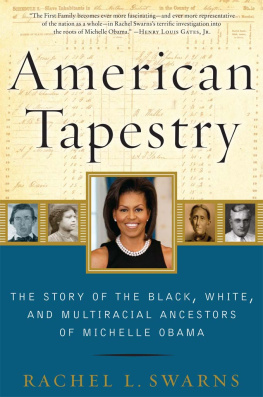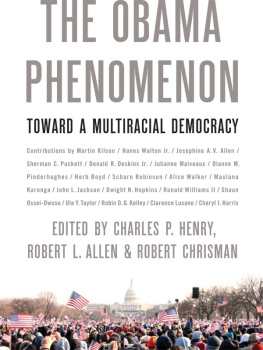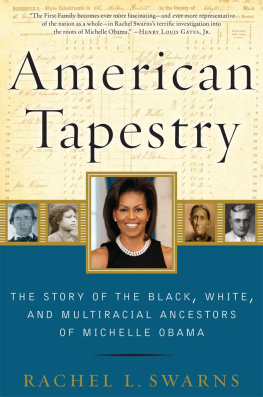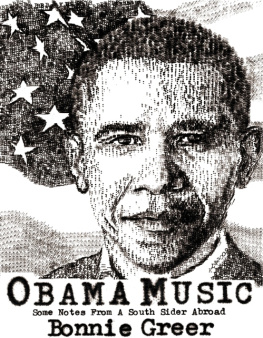
A MERICAN T APESTRY
THE STORY OF THE BLACK, WHITE, AND MULTIRACIAL ANCESTORS OF MICHELLE OBAMA
R ACHEL L. S WARNS

T O THOSE WHO CAME BEFORE
Contents
PROLOGUE
The Mystery of Michelle Obamas Roots
F REEDOM CAME TO J ONESBORO , G EORGIA, IN THAT SPRING of 1865, during those hardest of hard times. The town was in ruins, its buildings shattered by cannon fire. The fledgling green fields had been decimated by drought and hunger rippled through the land. Everywhere Southerners turned, people were moving. Many newly freed slaves were dropping their hoes and packing their sparse belongings. They were walking away from the parched earth and the white people who had owned them, overseen them, or marginalized them. Melvinia, a dark-eyed young woman with thick wavy hair and cocoa-colored skin, watched them go. Like all of them, she knew the miseries of slavery. She had toiled in bondage for most of her existence. She had been torn away from her family and friends when she was a little girl. She had been impregnated by a white man when she was as young as fourteen. Yet when the Civil War ended, when she could finally savor her own liberty, she decided to stay. She decided to build a new life right where she was, on the outskirts of that devastated town, on a farm near the white man who had fathered her firstborn son. She was barely in her twenties and silenced by the forced illiteracy of slavery. Even if she had wanted to, she could not have put pen to paper to reveal the name of the father of her child, to spell it out in the permanence of black ink. This was a different kind of affirmation. Her choice was her clue. A census taker would record her address after the war, memorializing her decision in his curly script. His notes would serve as something of a handwritten message that would survive, untouched, for more than one hundred years. It would be the only message Melvinia would ever leave.
Nearly a decade would pass before she gathered up her children and headed north on her own. Black people walked then, sometimes for miles and miles on those dusty, country roads, or squeezed onto the crowded, rattling railroad cars that chugged between small towns in rural, up-country Georgia. Sometime in the 1870s, Melvinia put some sixty miles between herself and her past. And somewhere along the way, she decided to keep the truth about her sons heritage to herself. People who knew her say she never talked about her time in slavery or about the white man who so profoundly shaped her formative years as a teenager and a young mother. She never discussed who he was or what happened between them, whether she was a victim of his brutality or a mistress he treated affectionately or whether she loved and was loved in return. She went her way and he went his, and, just like that, their family split right down the middle. Their children, grandchildren, and great-grandchildrensome black, some white, and some in betweenscattered across the country as the decades passed, separated by the color line and the familys fierce determination to step beyond its painful roots in slavery.
Contemporary America emerged from that multiracial stew, a nation peopled by the heirs of that agonizing time who struggled and strived with precious little knowledge of their own origins. Melvinias descendants would soar to unprecedented heights, climbing from slavery to the pinnacle of American power in five generations. Her great-great-great-granddaughter, Michelle Obama, would become the nations first African American First Lady. Yet Mrs. Obama would take that momentous step without knowing Melvinias name or the identity of the white man who was her great-great-great-grandfather. For more than a century, Melvinias secret held.
On November 4, 2008, some 143 years after Melvinia experienced her first days of freedom in that postwar wasteland, Mrs. Obama stood before a crowd of thousands of roaring, singing, and weeping supporters in Chicagos Grant Park. It was Election Night and her husband had just become the first African American president of the United States. Mrs. Obama was all warm smiles and gracious thank-yous that evening, the poised picture of a sophisticated, self-assured woman prepared to take her place in history. The truth was, though, that she knew very little about her own. The story of her husbands origins had become the powerful narrative that dominated the 2008 presidential campaign. The son of a white woman from Kansas and a black man from Kenya, Barack Obama embodied the hopes of many Americans eager to see an often-divided nation finally come together to fulfill its egalitarian ideals and step beyond its stains of inequality, segregation, and slavery. Mrs. Obamas smooth, chocolate-brown skin seemed to hold few surprises. She was born on the South Side of Chicago, in a working-class corner of the citys storied black community, just like her parents. Like many African Americans, her family had moved north during the Great Migration in the first half of the twentieth century. Mrs. Obama knew her grandparents as a girl, but only bits and pieces about the relatives who came before them. She had grown up hearing whispers about white ancestors in her family tree, but no one knew who they were. Melvinia was gone, buried and forgotten, and her name had long since faded from Mrs. Obamas family memory. The slave girls legacy may well have remained hidden were it not for two strangersone black and one whitewho happened to be watching Mrs. Obama on that stage on Election Night. The bloodlines of those two women also extended back to that devastated Georgia town. In the 1850s and 1860s, their ancestorsMelvinia, who was black, and Henry Wells Shields, who was whitelived together on a two-hundred-acre farm near Jonesboro where they picked cotton, raised cattle, and harvested bushels of Indian corn and sweet potatoes. Over time, those two women would begin unraveling their shared history and, in the process, the First Ladys as well. But that night, they knew none of it. They watched the Obamas as many of us did, as ordinary Americans eager to witness the moment unfolding before them.
Jewell Barclay, an eighty-year-old elementary-school crossing guard, clapped and cheered as she watched Mrs. Obama and her husband stride across her television screen. Jewell is a former cafeteria aide who went to work straight out of high school. She is a white-haired widow, an African American grandmother who has lived most of her life on a neat, tree-lined block in Cleveland. Schoolchildren and their mothers called to her by name whenever she walked byMiss Barclay! Miss Barclay!and Jewell, funny and kindhearted, consoled the troubled and cheered the brokenhearted. She thanked Jesus for living long enough to see this first black president and First Lady who looked so in love. In a small town outside of Atlanta, Joan Tribble, a sixty-five-year-old bookkeeper, was watching, too. Joan is a fiercely independent divorce with blue-gray eyes and an associates degree, who rarely hesitates to speak her mind. She prides herself on her common sense, her pointed wit, and her beloved grandchildren. She didnt vote for Mr. Obama. Too young and too inexperienced, she observed during the presidential campaign. She cast her ballot for his rival, John McCain, but admired Mrs. Obama from afar. A strong woman, she said, nodding approvingly. On Election Night, Joan peered through her wire-rimmed glasses as she tap-tapped the remote control, watching as the tableau of the young president-elect, his wife, and their daughters filled her living room.
Next page









